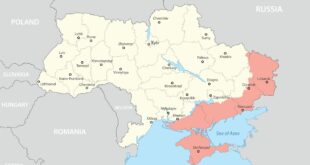This vivid portrayal of the ideological vision motivating the CCP and its leadership, emphasized by primary sources that the author draws on, is worth looking into.
For at least the past decade, China has been a topic of intense debate within foreign policy circles in the United States. One perspective holds that China is a rising power with the motive, means, and opportunity to surpass the United States as the world’s preeminent power or hegemon. Supporters of this view generally see China’s ascent as inexorable, and argue that the only way to prevent its global predominance is for the United States and Western democracies to wake up and take appropriate measures to revitalize themselves and counteract China’s increasingly assertive actions. This position often calls for the adoption of a grand strategy equivalent to the Cold War policy of containment, referred to by some as “Containment 2.0.”
In contrast, another perspective posits that China is not a rising power, but rather a faltering or peaking one. Advocates of this view, including authors such as Dan Blumenthal in his book China Nightmare, Hal Brands and Michael Beckley in their book Danger Zone and, most recently, Susan Shirk in her book Overreach, contend that the internal and external challenges facing China make it unlikely to continue its meteoric rise and therefore unlikely to displace the United States as the leader of the international order. Although these authors have varying opinions regarding the implications of peak China for global peace and security, they generally agree that those who emphasize China’s rise fail to appreciate the significant obstacles already limiting Beijing’s geopolitical aspirations.
In a provocative new book titled The Final Struggle, Ian Easton, Senior Director at the Project 2049 Institute and former China analyst at the Center for Naval Analyses, wades into this debate, mounting what amounts to a spirited counter-offensive against the latter perspective, which has gained considerable traction of late. Specifically, Easton argues that a strengthened and emboldened Chinese Communist Party (CCP) is now aggressively embarking on what Xi Jinping sometimes refers to as “the final struggle”—that is, the CCP’s historically inevitable campaign to remake the world in China’s own Marxist-Leninist image. According to Easton, a careful examination of Xi’s speeches, including some previously untranslated ones, reveal that the CCP is committed to imposing China’s communist totalitarian system on the entire world. But, Easton argued, this goal will not be achieved through the use of military force. Contrary to Hollywood portrayals of hordes of tanks and fascist stormtroopers “swarming across the map” and “goose-stepping into fallen capital cities,” or “communist paratroopers descending on sleepy American towns like they did in Red Dawn,” Easton argues that the CCP has adopted a much more sophisticated strategy for global domination. According to this strategy, he argues, the CCP has eschewed the fantasy of world conquest via military means in favor of “a protracted campaign of silent invasions to replicate on a global system what it sees as its own superior system.”
To achieve this end, Easton argues, the CCP has been quietly advancing its interests through a range of tactics, including economic coercion, technological influence, and propaganda campaigns. These efforts, he contends, are intended to culminate in the reshaping of the global balance of power in China’s favor and the creation of a Sino-centric world order reflecting the CCPs vision, values, and interests—unless, that is, we in the Western democracies collectively open our eyes and see clearly the “baleful vista of future possibilities, a totalitarian world order stalking us just over the horizon.”
Easton has written an ambitious book, one that has much to recommend it. Of particular note is the author’s vivid portrayal of the ideological vision motivating the CCP and its leadership and the richness of the primary sources that Easton draws on to substantiate his argument. The methodological foundation of Easton’s argument is that the CCP makes China’s foreign policy, and that therefore the way the top levels of the Party understand the world has a great deal to do with the way Beijing acts in the world. This places an evident premium on understanding how the CCP’s leaders—and Xi Jinping, as head of the Party, in particular—imagine the future of world order. And this, in turn, places a premium on identifying those Party documents that are “authoritative” or that clearly reflect the “common sense” or “conventional wisdom” within the Party. This, Easton does to a fault. The book is informed by an array of primary sources, some never before translated into English, the likes of which have seldom been made available to a non-specialist audience in the West. Indeed, the only book that comes close in this respect is Rush Doshi’s The Long Game, which covers some of the same terrain, even if for slightly different purposes. Like Doshi’s, Easton’s book deftly uses primary sources to paint a picture of China’s global ambitions that is intended to shock Western audiences out of their assumed numbness regarding the CCP’s true ambitions.
That brings us to the book’s shortcomings, two of which stand out in stark relief.
The first is stylistic verging on substantive. Simply put, Easton’s book tends unambiguously—and counterproductively—toward sensationalism. The descriptions of the CCP’s rule and the characterizations of its vision of the future fall somewhere between hysterical and hyperbolic, with lurid being perhaps the word that best reflects the picture developed. This may achieve the shock effect that Easton obviously seeks, but it also threatens to amplify the growing—and increasingly dangerous—tendency to portray China as a kind of monster that the United States must go abroad to destroy.
The second has to do with timing: Easton’s book seems about a decade out of time. The current debate about China’s grand strategy turns not so much on the issue of the CCP’s motives as on its means. The animating question at the heart of the China debate today has little to do with China’s goals or aspirations. Rather, it has to do with the issue of whether China is a rising power or one that is plateauing. Warranted or not, there is—and has been for some time now—a general consensus that China is bent on establishing either regional or global hegemony. The animating question of the current moment is whether Beijing will ever be in a position to realize either of these goals, given the demographic, economic, and geopolitical headwinds the country is facing. The big debate between those who imagined China to be a status quo power gently rising within the liberal international order and those who imagined it to be a more threatening player on the world stage—the debate that Easton seems keen to participate in—has been over since at least the second term of the Obama administration. 2022 seems a strange time to try to throw one’s hat into that particular ring.
If you are seeking the experience of terror, anxiety, and shock typically associated with a good horror story, then The Final Struggle is the book for you. If, however, you are looking for a serious analysis of China’s grand strategy or Sino-American strategic competition, then perhaps you should look elsewhere.
Andrew Latham is Professor of International Relations and Political Theory at Macalester College, St. Paul, MN, a Research Associate with the Centre for Defence and Security Studies, Canada, and a Senior Fellow at the Institute for Peace and Diplomacy.
Logan Leybold is a research assistant in the Political Science Department at Macalester College.
 Geostrategic Media Political Commentary, Analysis, Security, Defense
Geostrategic Media Political Commentary, Analysis, Security, Defense





